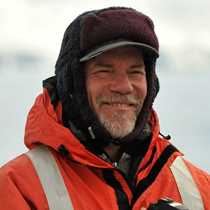What in the world is this? Certainly not one of Alaska’s better-known creatures... During our week-long exploration of Southeast Alaska, we use our intimate knowledge of the region, gained over 20 years of experience cruising these fiords and islands, to seek out the homes and haunts of many species of wildlife. Most of these are well-known icons of the northern forests and seas. Humpback whales breaching in the sparkling water of a sunny morning, sea otters sculling slowly through the kelp with their babies on their bellies, puffins swimming beside sea lions, a lone black bear feeding on the steep rocky shore of a long fiord; maybe we’ll find Killer Whales around the next bend. These are wildlife encounters we dreamed about, read about and eagerly anticipated before we came to Alaska, and now they surround us, day and night.
But the high-tech expedition gear on board the Sea Bird allows us to see facets of this great wilderness that we never imagined existed, creatures that few people have ever seen, or even heard of. The video microscope can show us the infinitesimal world inside a few drops of seawater, teeming with tiny plants and animals that form the basis of the marine food chain that ultimately supports the humpback whales we love. And deeper in the sea, our underwater digital video camera reveals an entire ecosystem, as rich as the forests above, hidden in the silence and darkness beneath the cold Alaskan waves.
This rare and beautiful creature is a Dall’s Aeolid, a nudibranch or sea slug, named in honor of William Healy Dall, the same biologist explorer whose name is given to Dall’s porpoise and Dall’s sheep. Nudibranchs are remarkable creatures, at home in all of the world’s oceans, related to land slugs, snails, clams and other molluscs. In this photo, the animal’s head is to the right, bearing a fringe of oral tentacles which it uses to locate it prey, and a pair of stalked sense organs called rhinophores. These are chemosensors (they are used to smell the water) and they are sensitive enough to detect trace compounds left in slime trails by other nudibranchs, cues that may indicate the presence of food or danger. Lining the animal’s back are cerrata, spiky projections which act as gills, hence the name nudibranch or “naked gill.” Diving along the outer coast of Chichagof Island today, I was thrilled to find a pair of these animals on a rocky ledge sixty feet down. I carefully recorded them with the video camera in order to share them with everyone on board, an unusual and exciting addition to our wildlife list.
The truly delightful thing about Alaskan wildlife is how rich and varied it is. Every gram of soil contains countless thousands of tiny creatures. The trunks of the great trees of the rainforest are home to mosses, lichens and fungi. Whales carry barnacles on their flukes. The closer you look the more you find, worlds within worlds, a wonderful opportunity for genuine exploration.




